Electrical Permittivity and Conductivity of a Graphene Nanoplatelet Contact in the Microwave Range
Abstract
:1. Introduction
2. Materials and Methods
2.1. Preparation and Structural Characterization of the Sample Circuits
2.2. Electromagnetic Model
2.3. Electromagnetic Characterization
3. Results and Discussion
3.1. Structural Characterization of the Nanomaterial and of the Circuit
3.2. Electromagnetic Simulations and Sensitivity Analysis
3.3. Electromagnetic Characterization and Results Discussion
4. Conclusions
Author Contributions
Funding
Conflicts of Interest
References
- International Technology Roadmap for Semiconductors, ITRS. Available online: www.itrs2.net (accessed on 26 October 2018).
- Saito, R.; Dresselhaus, G.; Dresselhaus, M.S. Physical Properties of Carbon Nanotubes; Imperial College Press: Singapore, 2004. [Google Scholar]
- Castro Neto, A.H.; Guinea, F.; Peres, N.M.R.; Novoselov, K.S.; Geim, A.K. The electronic properties of graphene. Rev. Mod. Phys. 2009, 81, 109–162. [Google Scholar] [CrossRef] [Green Version]
- Bellucci, S. Carbon nanotubes: Physics and applications. Phys. Status Solidi A 2005, 2, 34–47. [Google Scholar] [CrossRef]
- Avouris, P.; Chen, Z.; Perebeinos, V. Carbon Based Electronics. Nat. Nanotechnol. 2007, 2, 605. [Google Scholar] [CrossRef] [PubMed]
- Torrisi, F.; Hasan, T.; Wu, W.; Sun, Z.; Lombardo, A.; Kulmala, T.S.; Hsieh, G.W.; Jung, S.; Bonaccorso, F.; Paul, P.J.; et al. Inkjet-printed Graphene Electronics. ACS Nano 2012, 6, 2992–3006. [Google Scholar] [CrossRef] [PubMed]
- Morris, J.E.; Iniewski, K. Graphene, Carbon Nanotubes, and Nanostructures: Techniques and Applications; CRC-Press: Boca Raton, FL, USA, 2013. [Google Scholar]
- Jariwala, D.; Sangwan, V.K.; Lauhon, L.J.; Marksab, T.J.; Hersam, M.C. Carbon nanomaterials for electronics, optoelectronics, photovoltaics, and sensing. Chem. Soc. Rev. 2013, 7, 2824–2860. [Google Scholar] [CrossRef] [PubMed]
- Kuzhir, P.; Paddubskaya, A.; Bychanok, D.; Nemilentsau, A.; Shuba, M.; Plusch, A.; Maksimenko, S.; Bellucci, S.; Coderoni, L.; Micciulla, F.; et al. Microwave probing of nanocarbon based epoxy resin composite films: Toward electromagnetic shielding. Thin Solid Films 2011, 519, 4114–4118. [Google Scholar] [CrossRef]
- Bychanok, D.S.; Plyushch, A.O.; Gorokhov, G.V.; Bychanok, U.S.; Kuzhira, P.P.; Maksimenko, S.A. Microwave Radiation Absorbers Based on Corrugated Composites with Carbon Fibers. Techn. Phys. 2016, 61, 1880–1884. [Google Scholar] [CrossRef]
- Plyushch, A.; Macutkevic, J.; Kuzhir, P.; Banys, J.; Bychanok, D.; Lambin, P.; Bistarelli, S.; Cataldo, A.; Micciulla, F.; Bellucci, S. Electromagnetic properties of graphene nanoplatelets/epoxy composites. Compos. Sci. Technol. 2016, 128, 75–83. [Google Scholar] [CrossRef]
- Sarto, M.S.; D’Aloia, A.G.; Tamburrano, A.; De Bellis, G. Synthesis, Modeling, and Experimental Characterization of Graphite Nanoplatelet-Based Composites for EMC Applications. IEEE Trans. Electromagn. Compat. 2017, 54, 17–27. [Google Scholar] [CrossRef]
- Li, H.; Xu, C.; Srivastava, N.; Banerjee, K. Carbon Nanomaterials for Next-Generation Interconnects and Passives: Physics, Status, and Prospects. IEEE Trans. Electron Dev. 2009, 56, 799–1821. [Google Scholar] [CrossRef]
- Todri-Sanial, A.; Dijon, J.; Maffucci, A. Carbon Nanotubes for Interconnects: Process, Design and Applications; Springer: Cham, The Netherlands, 2016. [Google Scholar]
- Slepyan, G.Y.; Boag, A.; Mordachev, V.; Sinkevich, E.; Maksimenko, S.; Kuzhir, P.; Miano, G.; Portnoi, M.E.; Maffucci, A. Nanoscale Electromagnetic Compatibility: Quantum Coupling and Matching in Nanocircuits. IEEE Trans. Electromagn. Compat. 2015, 57, 1645–1654. [Google Scholar] [CrossRef]
- Maffucci, A. Carbon nanotubes in nanopackaging applications. IEEE Nanotechnol. Mag. 2009, 3, 22–25. [Google Scholar] [CrossRef]
- Morris, J.E. Nanopackaging: Nanotechnologies and Electronics Packaging; Springer: New York, NY, USA, 2018. [Google Scholar]
- Franklin, A.D.; Luisier, M.; Han, S.-J.; Tulevski, G.; Breslin, C.M.; Gignac, L.; Lundstrom, M.S.; Haensch, W. Sub-10 nm Carbon Nanotube Transistor. Nano Lett. 2012, 12, 758–762. [Google Scholar] [CrossRef] [PubMed]
- Valitova, I.; Amato, M.; Mahvash, F.; Cantele, G.; Maffucci, A.; Santato, C.; Martel, R.; Cicoira, F. Carbon nanotube electrodes in organic transistors. Nanoscale 2013, 5, 4638–4646. [Google Scholar] [CrossRef] [PubMed]
- Shuba, M.V.; Slepyan, G.Y.; Maksimenko, S.A.; Thomsen, C.; Lakhtakia, A. Theory of multiwall carbon nanotubes as waveguides and antennas in the infrared and the visible regimes. Phys. Rev. B 2009, 79, 155403. [Google Scholar] [CrossRef]
- Berres, J.A.; Hanson, G.W. Multiwall carbon nanotubes at RF-THz frequencies: Scattering, shielding, effective conductivity, and power dissipation. IEEE Trans. Antennas Prop. 2011, 59, 3098–3103. [Google Scholar] [CrossRef]
- Hartmann, R.R.; Kono, J.; Portnoi, M.E. Terahertz science and technology of carbon nanomaterials. Nanotechnology 2014, 25, 322001. [Google Scholar] [CrossRef] [Green Version]
- Dabrowska, A.; Bellucci, S.; Cataldo, A.; Micciulla, F.; Huczk, A. Nanocomposites of epoxy resin with graphene nanoplates and exfoliated graphite: Synthesis and electrical properties. Phys. Status Solidi B 2014, 251, 2599–2602. [Google Scholar] [CrossRef]
- Maffucci, A.; Micciulla, F.; Cataldo, A.; Miano, G.; Bellucci, S. Bottom-up Realization and Electrical Characterization of a Graphene-Based Device. Nanotechnology 2016, 27, 095204. [Google Scholar] [CrossRef]
- Wu, H.; Drzal, L.T. Graphene nanoplatelet paper as a light-weight composite with excellent electrical and thermal conductivity and good gas barrier properties. Carbon 2012, 50, 1135–1145. [Google Scholar] [CrossRef]
- Pierantoni, L.; Mencarelli, D.; Bozzi, M.; Moro, R.; Moscato, S.; Perregrini, L.; Micciulla, F.; Cataldo, A.; Bellucci, S. Broadband Microwave Attenuator Based on Few Layer Graphene Flakes. IEEE Trans. Microw. Theory Tech. 2015, 63, 2491–2497. [Google Scholar] [CrossRef]
- Yasir, M.; Savi, P.; Bistarelli, S.; Cataldo, A.; Bozzi, M.; Perregrini, L.; Bellucci, S. A Planar Antenna with Voltage-Controlled Frequency Tuning Based on Few-Layer Graphene. IEEE Antennas Wirel. Propag. Lett. 2017, 16, 2380–2383. [Google Scholar] [CrossRef]
- Wilhite, P.; Vyas, A.A.; Tan, J.; Yamada, T.; Wang, P.; Park, J.; Yang, C.Y. Metal nanocarbon contacts. Semicond. Sci. Technol. 2014, 29, 054006. [Google Scholar] [CrossRef]
- Chiariello, A.G.; Miano, G.; Maffucci, A. Size and temperature effects on the resistance of copper and carbon nanotubes nano-interconnects. In Proceedings of the IEEE 19th Conference on Electrical Performance of Electronic Packaging and Systems, EPEPS, Austin, TX, USA, 25–27 October 2010; pp. 97–100. [Google Scholar]
- Bellucci, S.; Bistarelli, S.; Cataldo, A.; Micciulla, F.; Kranauskaite, I.; Macutkevic, J.; Banys, J.; Volynets, N.; Paddubskaya, A.; Bychanok, D.; et al. Broadband Dielectric Spectroscopy of Composites Filled with Various Carbon Materials. IEEE Trans. Microw. Theory Tech. 2015, 63, 2024–2031. [Google Scholar] [CrossRef]
- Chen, L.F.; Ong, C.K.; Neo, C.P.; Varadan, V.V.; Varadan, V.K. Microwave Electronics: Measurement and Materials Characterization; John Wiley & Sons: New York, NY, USA, 2004. [Google Scholar]
- Anderson, J.M.; Sibbald, C.L.; Stuchly, S.S. Dielectric Measurements Using a Rational Function Model. IEEE Trans. Microw. Theory Tech. 1994, 42, 199–204. [Google Scholar] [CrossRef]
- CST Microwave Studio. Available online: https://www.cst.com (accessed on 10 July 2018).
- Griffiths, D.J. Introduction to Electrodynamics; Prentice-Hall: Englewood Cliffs, NJ, USA, 1999. [Google Scholar]
- Bryant, G.H. Principles of Microwave Measurements; IEE Electrical Measurement Series 5; Peter Peregrinus: London, UK, 1988. [Google Scholar]
- Silvonen, K.J. A General Approach to Network Analyzer Calibration. IEEE Trans. Microw. Theory Tech. 1992, 40, 754–759. [Google Scholar] [CrossRef]
- Li, Y.C.; Tjong, S.C.; Li, R.K.Y. Electrical conductivity and dielectric response of poly(vinylidene fluoride)–graphite nanoplatelet composites. Synth. Met. 2010, 160, 1912–1919. [Google Scholar] [CrossRef]
- Swaminathan, M.; Han, K.J. Design and Modeling for 3D ICs and Interposers; World Scientific Publishing Company: Singapore, 2014. [Google Scholar]
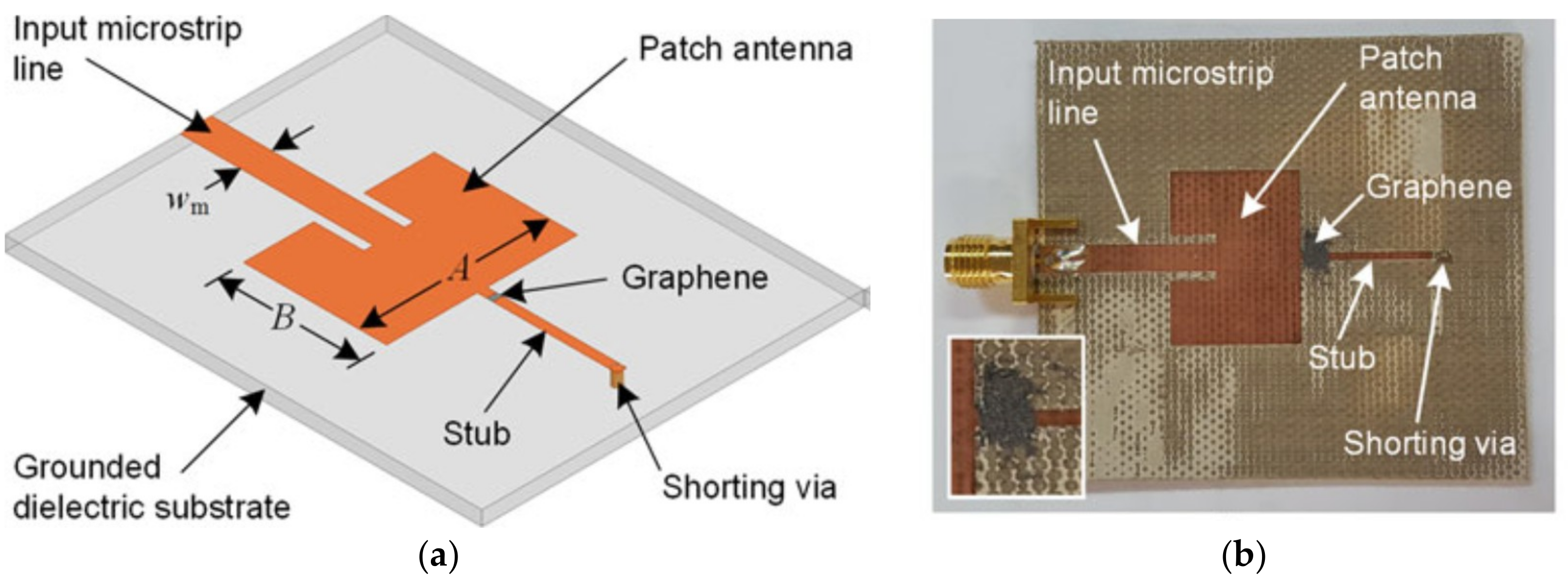

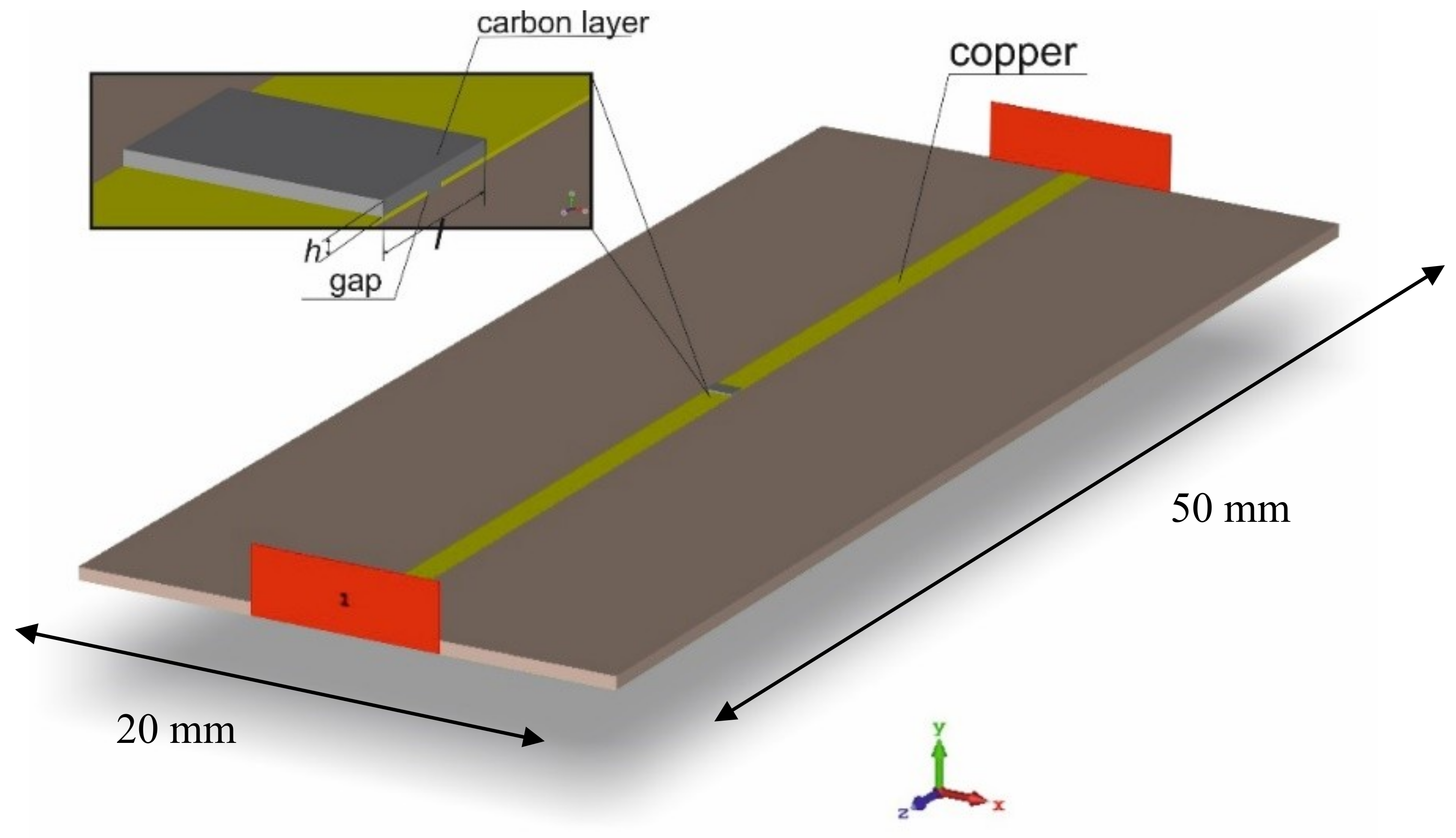
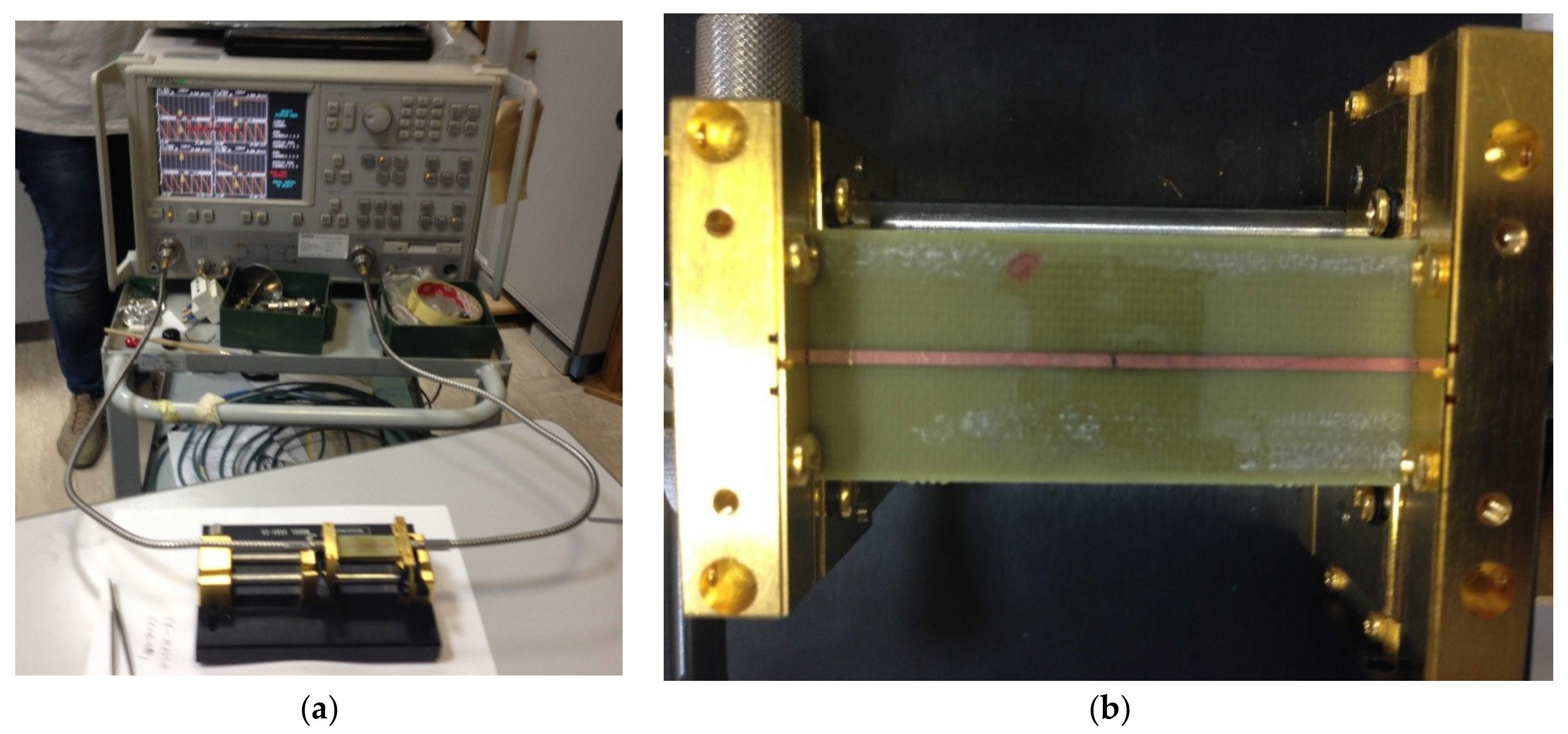
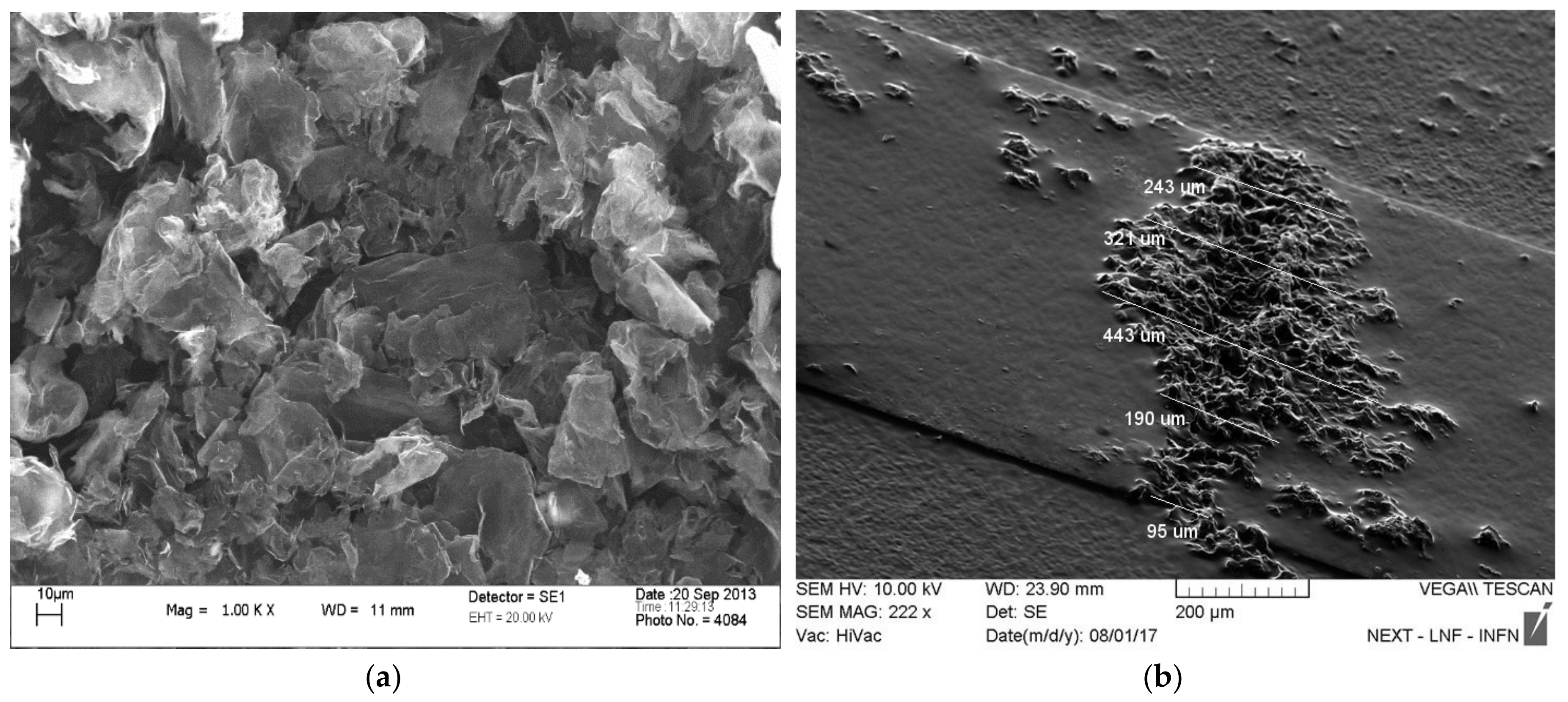

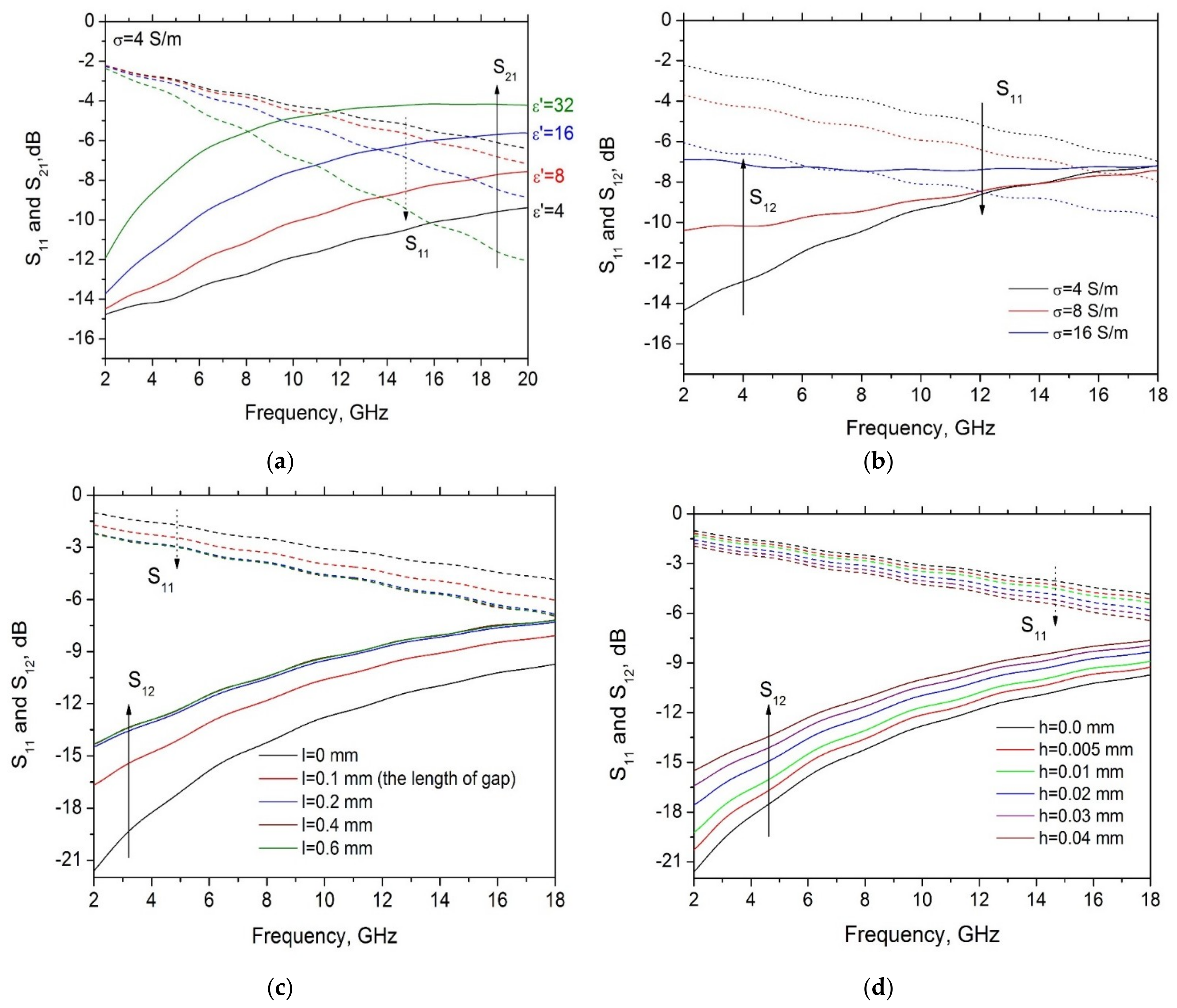
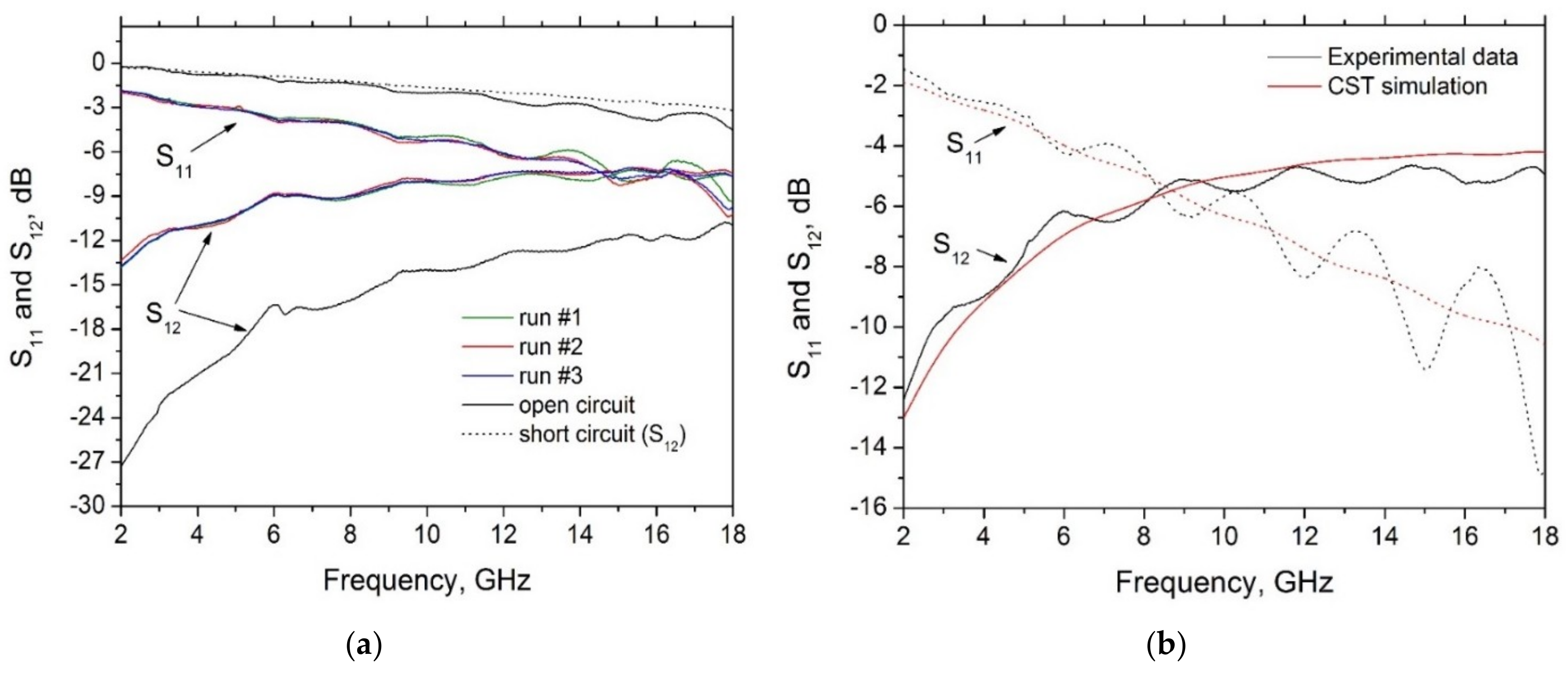
| A (mm) | B (mm) | W (mm) | H (mm) | L (mm) |
|---|---|---|---|---|
| 50 | 20 | 1.0 | 0.5 | 0.1 |
| Element | C | O | Fe | Na | Mg | Al | Si | S | Ca | Cr |
| Content (%) | 87.10 | 10.90 | 0.13 | 0.16 | 0.13 | 0.24 | 0.59 | 0.38 | 0.21 | 0.11 |
| Dimension | Sample 1 | Sample 2 |
|---|---|---|
| h (µm) | 10–20 | 48–55 |
| l (mm) | 0.10–0.44 | 0.10–0.50 |
| Parameter | Sample 1 | Sample 2 |
|---|---|---|
| σ(DC) (S/m) | 2.4 | 2.5 |
| σ (S/m) | 4 | 10 |
| 23 | 40 |
© 2018 by the authors. Licensee MDPI, Basel, Switzerland. This article is an open access article distributed under the terms and conditions of the Creative Commons Attribution (CC BY) license (http://creativecommons.org/licenses/by/4.0/).
Share and Cite
Bellucci, S.; Maffucci, A.; Maksimenko, S.; Micciulla, F.; Migliore, M.D.; Paddubskaya, A.; Pinchera, D.; Schettino, F. Electrical Permittivity and Conductivity of a Graphene Nanoplatelet Contact in the Microwave Range. Materials 2018, 11, 2519. https://doi.org/10.3390/ma11122519
Bellucci S, Maffucci A, Maksimenko S, Micciulla F, Migliore MD, Paddubskaya A, Pinchera D, Schettino F. Electrical Permittivity and Conductivity of a Graphene Nanoplatelet Contact in the Microwave Range. Materials. 2018; 11(12):2519. https://doi.org/10.3390/ma11122519
Chicago/Turabian StyleBellucci, Stefano, Antonio Maffucci, Sergey Maksimenko, Federico Micciulla, Marco D. Migliore, Alesia Paddubskaya, Daniele Pinchera, and Fulvio Schettino. 2018. "Electrical Permittivity and Conductivity of a Graphene Nanoplatelet Contact in the Microwave Range" Materials 11, no. 12: 2519. https://doi.org/10.3390/ma11122519






